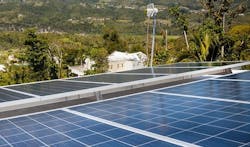Sunnova wants to build and run Community Microgrids as a Utility
Find complete Microgrid sector coverage at Microgrid Knowledge
Residential solar company Sunnova Energy took the bold and unusual step yesterday of seeking regulatory approval in California to act as a utility that owns and operates community microgrids.
Microgrid developers have typically avoided being designated as utilities — in some cases fought against it — because few have the resources to take on the level of regulation applied to utilities.
However, Sunnova is tapping into a unique “microutility” designation conceived by California regulators. Microutilities would serve fewer than 2,000 customers under lightened regulation.
The proposal arrives as the state’s grid labors under extreme heat. The California Independent System Operator this week called for conservation to avert the kind of blackout the state saw in August 2020.
The grid warning comes on top of the more frequent public safety power shutoffs that Californians are experiencing as utilities try to prevent power lines from sparking wildfires.
For new neighborhoods
The Texas-based company wants to install the microgrids in partnership with real estate developers who are building new neighborhoods in California.
In a typical 500-home community, each home would act as a nanogrid, with separately metered on-site solar PV and battery energy storage, oversized so that excess energy could flow to the community or the grid. The neighborhood also would have community solar, energy storage, emergency generation and microgrid controls and software and could function as a virtual power plant.
During a grid outage, the microgrid would island from the grid and the community would rely on its on-site power. The design allows the microgrid to operate independently for a minimum of 300 hours.
About 82% of the community’s power would come from the microgrid with the remainder coming from the grid. The microgrid would cost about $16,000 to $20,000 per home, Sunnova said in the Sept. 1 filing before the California Public Utilities Commission.
Sunnova would operate the microgrids and employ software and predictive analytics to manage the assets and energy imports and exports. Households will also be equipped with platforms so that they can monitor and adjust their energy use.
The renewable energy microgrids will offer the state a range of benefits, among them increased electric reliability, advancement toward utility sustainability goals, jobs and grid services, according to the filing.
By building community microgrids California also can avoid expensive grid upgrades, Sunnova said, citing a $40 billion price estimate to underground utility distribution lines.
Editor's Note: Microgrid Knowledge and EnergyTech are sister websites of Endeavor Business Media.
